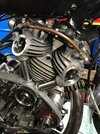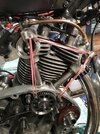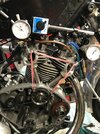You are using an out of date browser. It may not display this or other websites correctly.
You should upgrade or use an alternative browser.
You should upgrade or use an alternative browser.
ET: Engine (Twin) Checking the Cam timing on a twin
- Thread starter Freebird
- Start date
First you need to get a degree plate, an index pointer to point at the degree plate and a piston stop. Then you can find top dead centre. You do this by rotating the engine, slowly, up to the piston stop from each direction, halving the readings, adjusting the rotational position of the degree plate until you get exactly the same reading each side of the TDC position. Now remove the piston stop.
You will also need two dial gauges to fit over the top of the valve stems. If the engine is still in the frame (UFM) then you need to make up some method of measuring the lift on the top of the tappet adjuster. There was an item on here a few years back about making and extended pushrod which could sit in the cam follower hollow and have a flat on top which could move the dial gauge. That looked like a good idea to me. Whatever you do you need to be able to measure the lift of the valves, or pushrods, as the engine is rotated. Then rotate the engine in the forwards direction so that the inlet valve lifts, drops and closes. You will then be on the compression stroke. Keep rotating the engine. You should be able to see the exhaust valve closing and the inlet valve opening. When you have exactly the same lift on both valves the degree plate should read 4 deg BTDC. If it does not then you have to alter the valve timing so that you have the same lift on inlet and exhaust valve at 4 to 6 degrees BTDC. To do this you have to get access to the cam and valve gear inside the timing cover. That means taking off the timing cover, the steady plate and various other bits so that the cams can be rotated on the cylinder you are working on. One needs patience but there is nothing that requires an academic education or a brain the size of a minor planet. Just patience and concentration.
If all this seems like black magic to you then sit down quietly and think about how about a four stroke engine works. It will eventually become clear.
You will also need two dial gauges to fit over the top of the valve stems. If the engine is still in the frame (UFM) then you need to make up some method of measuring the lift on the top of the tappet adjuster. There was an item on here a few years back about making and extended pushrod which could sit in the cam follower hollow and have a flat on top which could move the dial gauge. That looked like a good idea to me. Whatever you do you need to be able to measure the lift of the valves, or pushrods, as the engine is rotated. Then rotate the engine in the forwards direction so that the inlet valve lifts, drops and closes. You will then be on the compression stroke. Keep rotating the engine. You should be able to see the exhaust valve closing and the inlet valve opening. When you have exactly the same lift on both valves the degree plate should read 4 deg BTDC. If it does not then you have to alter the valve timing so that you have the same lift on inlet and exhaust valve at 4 to 6 degrees BTDC. To do this you have to get access to the cam and valve gear inside the timing cover. That means taking off the timing cover, the steady plate and various other bits so that the cams can be rotated on the cylinder you are working on. One needs patience but there is nothing that requires an academic education or a brain the size of a minor planet. Just patience and concentration.
If all this seems like black magic to you then sit down quietly and think about how about a four stroke engine works. It will eventually become clear.
The method relies on understanding that there is one position where both the intake and the exhaust valves are at exactly the same lift. This is because there is one position where both valves are open for a short period, which is called "the overlap." The trick is realizing that the Factory marked this position by striking marks on all the timing gears that would line up for this very brief positioning of the valves at equal lift. Unfortunately, the Factory also used the "hunting tooth" method of design to prevent wear on the gears, so the gear teeth, as well as the timing marks on the gears, line up once every 76 turns, whereas the valves are at equal lift every two revolutions of the engine.
The best way to measure what is happening is to use two digital dial indicators because you can simply zero the indicators at TDC and then watch the dials to see when the numbers match each other, say at 0.120". One dial will read +.120, and the other will read -.120. Your degree wheel should be at 4 degrees before TDC, with the exhaust valve closing. This TDC is not the one where where you adjust the pushrods...that one is 180 degees different. TDC compression is on one side of the cam, and TDC overlap is 180 degrees different, between the cam lobes. The Factory selected 4 degrees before TDC between the lobes because they liked the performance a little better.
David
The best way to measure what is happening is to use two digital dial indicators because you can simply zero the indicators at TDC and then watch the dials to see when the numbers match each other, say at 0.120". One dial will read +.120, and the other will read -.120. Your degree wheel should be at 4 degrees before TDC, with the exhaust valve closing. This TDC is not the one where where you adjust the pushrods...that one is 180 degees different. TDC compression is on one side of the cam, and TDC overlap is 180 degrees different, between the cam lobes. The Factory selected 4 degrees before TDC between the lobes because they liked the performance a little better.
David
I have done it with a Vernier height gauge but I don't recommend it. I also used analog dial gauges but watching those contra rotating dials soon had me in a spin, digital gauges are best.
note also while you may get a comet spot on I doubt you will get a twin both to 4 degrees I guess 6-3 is a good range
you can do a single by working back to front. Lock the cam at equal opening then rotate the crank to 4 degrees and finally find the best key-way on the half time pinion.
also note the picture in Vincent Richardson. as a guide the 'notch' in on both cams centres points between the push rod tubes
note also while you may get a comet spot on I doubt you will get a twin both to 4 degrees I guess 6-3 is a good range
you can do a single by working back to front. Lock the cam at equal opening then rotate the crank to 4 degrees and finally find the best key-way on the half time pinion.
also note the picture in Vincent Richardson. as a guide the 'notch' in on both cams centres points between the push rod tubes
All excellent stuff, thank for the rapid replies.
So, you zero the DTIs at TDC on the compression stroke, then rotate the crank roughly 176° to where both valves show the same lift? If that is the case, both DTIs will show +0.120" as both have opened - would they not?
The best way to measure what is happening is to use two digital dial indicators because you can simply zero the indicators at TDC and then watch the dials to see when the numbers match each other, say at 0.120". One dial will read +.120, and the other will read -.120. Your degree wheel should be at 4 degrees before TDC, with the exhaust valve closing.
David
So, you zero the DTIs at TDC on the compression stroke, then rotate the crank roughly 176° to where both valves show the same lift? If that is the case, both DTIs will show +0.120" as both have opened - would they not?
You will not get 120 thou unless you have racing cams for the reading in the middle of the overlap. You will get about fifty thou for a touring cam and you are right, both values will have the same sign.
If you search you will find lots of information. Here is a link to one of several threads that cover equal timing at 4º BTDC at the end of the exhaust stroke
Timing equal-lift-at-4-degrees BTDC
Timing equal-lift-at-4-degrees BTDC



